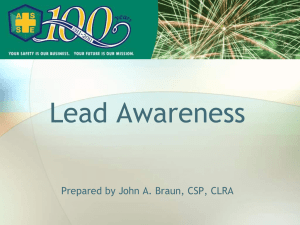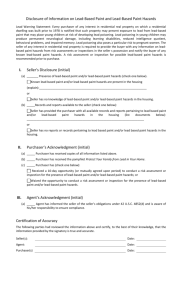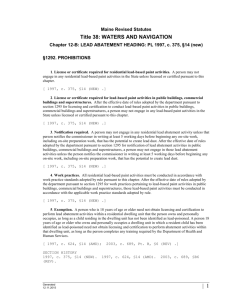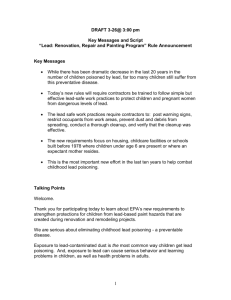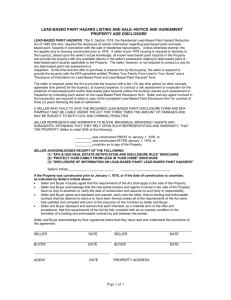enforcement of lead-based paint disclosure rule
advertisement
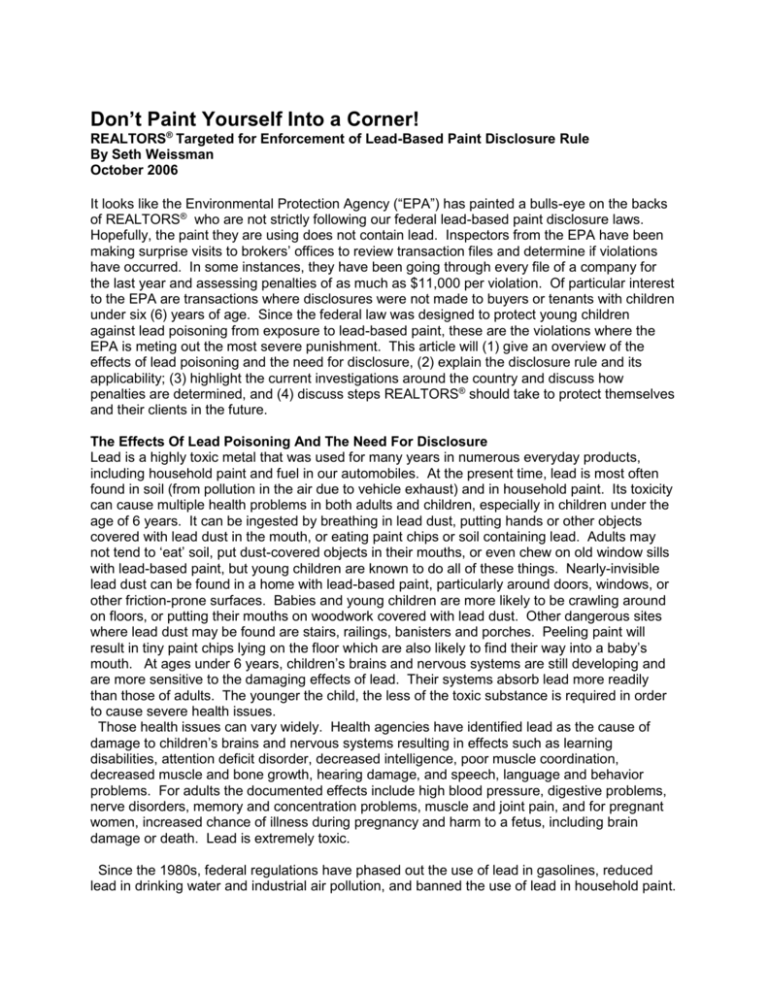
Don’t Paint Yourself Into a Corner! REALTORS® Targeted for Enforcement of Lead-Based Paint Disclosure Rule By Seth Weissman October 2006 It looks like the Environmental Protection Agency (“EPA”) has painted a bulls-eye on the backs of REALTORS® who are not strictly following our federal lead-based paint disclosure laws. Hopefully, the paint they are using does not contain lead. Inspectors from the EPA have been making surprise visits to brokers’ offices to review transaction files and determine if violations have occurred. In some instances, they have been going through every file of a company for the last year and assessing penalties of as much as $11,000 per violation. Of particular interest to the EPA are transactions where disclosures were not made to buyers or tenants with children under six (6) years of age. Since the federal law was designed to protect young children against lead poisoning from exposure to lead-based paint, these are the violations where the EPA is meting out the most severe punishment. This article will (1) give an overview of the effects of lead poisoning and the need for disclosure, (2) explain the disclosure rule and its applicability; (3) highlight the current investigations around the country and discuss how penalties are determined, and (4) discuss steps REALTORS® should take to protect themselves and their clients in the future. The Effects Of Lead Poisoning And The Need For Disclosure Lead is a highly toxic metal that was used for many years in numerous everyday products, including household paint and fuel in our automobiles. At the present time, lead is most often found in soil (from pollution in the air due to vehicle exhaust) and in household paint. Its toxicity can cause multiple health problems in both adults and children, especially in children under the age of 6 years. It can be ingested by breathing in lead dust, putting hands or other objects covered with lead dust in the mouth, or eating paint chips or soil containing lead. Adults may not tend to ‘eat’ soil, put dust-covered objects in their mouths, or even chew on old window sills with lead-based paint, but young children are known to do all of these things. Nearly-invisible lead dust can be found in a home with lead-based paint, particularly around doors, windows, or other friction-prone surfaces. Babies and young children are more likely to be crawling around on floors, or putting their mouths on woodwork covered with lead dust. Other dangerous sites where lead dust may be found are stairs, railings, banisters and porches. Peeling paint will result in tiny paint chips lying on the floor which are also likely to find their way into a baby’s mouth. At ages under 6 years, children’s brains and nervous systems are still developing and are more sensitive to the damaging effects of lead. Their systems absorb lead more readily than those of adults. The younger the child, the less of the toxic substance is required in order to cause severe health issues. Those health issues can vary widely. Health agencies have identified lead as the cause of damage to children’s brains and nervous systems resulting in effects such as learning disabilities, attention deficit disorder, decreased intelligence, poor muscle coordination, decreased muscle and bone growth, hearing damage, and speech, language and behavior problems. For adults the documented effects include high blood pressure, digestive problems, nerve disorders, memory and concentration problems, muscle and joint pain, and for pregnant women, increased chance of illness during pregnancy and harm to a fetus, including brain damage or death. Lead is extremely toxic. Since the 1980s, federal regulations have phased out the use of lead in gasolines, reduced lead in drinking water and industrial air pollution, and banned the use of lead in household paint. According to the EPA, approximately seventy-five percent of homes built before 1978 contain lead-based paint. (Its use was banned beginning in 1978.) In the 1990s additional regulations were adopted requiring that sellers and landlords of residential properties, and their agents, make various disclosures relative to the risk of lead-based paint if the property they are selling/leasing was constructed prior to 1978. The regulations have definitely helped. Since 1978 it is estimated that the number of children with elevated levels of lead in their systems has dropped by at least 80-90%. The Disclosure Rule And Its Applicability The Environmental Protection Agency (EPA) and the Department of Housing and Urban Development (HUD) have promulgated joint regulations for the disclosure of lead-based paint in pre-1978 housing (“target housing”) which is offered for sale or lease. While the regulations apply to the vast majority of pre-1978 residential construction, certain types of housing are exempt. First, the regulations do not apply to any purely commercial property such as an office building or a retail store, but only apply to residential property. Any 0-bedroom dwellings (such as lofts, efficiencies or studios) and any housing for the elderly or persons with disabilities (unless young children are expected to reside there as well) are exempt. All other pre-1978 residential housing is considered target housing. Under the federal regulations sellers, lessors, and their agents must provide purchasers or lessees and their agents with certain information. The requirements of the disclosure rule set forth below are the same whether the property is being sold or leased, with one additional requirement when the transaction is a sale: (1) a Lead Warning Statement consisting of specific language;1 (2) a statement by the seller/lessor disclosing the presence of any known lead-based paint and/or hazards therefrom in the target housing, OR indicating no knowledge of same. If the seller/lessor does have such knowledge, the specific information must be provided (how the determination was made, the location of the paint hazards, and the condition of the painted surfaces); (3) a list of any records or reports available to seller/lessor regarding the condition, or a statement that no such records or reports are available; (4) a statement by the purchaser/lessee that he/she has received the information set out above and the lead hazard information pamphlet published by the EPA; (5) with respect to a sale only, a statement by the purchaser that he/she has either received or waived the opportunity to conduct a risk assessment or inspection to determine the presence of lead-based paint or lead-based paint hazards. When one or more agents are involved in the transaction, there must also be included a statement that the agent: (6) has informed the seller/lessor of his or her obligations of disclosure, and (7) is aware of his or her responsibility to ensure compliance with these requirements. The attachment must contain the signatures of sellers/lessors, agents, and purchasers/lessees certifying the accuracy of their statements to the best of their knowledge, and setting out the dates of signatures. The GAR forms include the appropriate disclosures and acknowledgment, but the timing of the disclosure is as important as the content. The required disclosures must be made before a prospective purchaser or tenant is obligated under any contract to purchase or lease the target housing. When there is a Seller’s Property Disclosure Statement completed as part of a transaction, page 4 of the GAR Form F50 includes the required disclosures and 2 acknowledgments. (If a Disclosure Statement is not used, the form entitled “Lead-Based Paint Exhibit” fully covers all of the requirements of these regulations as well.) REALTORS® should note that the GAR Form F50 contains the statement that the “disclosures must occur prior to Seller’s acceptance of Buyer’s written offer to purchase” and that Seller cannot accept the offer until the disclosure is made and the buyer has had the opportunity to review the information disclosed to consider whether to amend the offer. One common way REALTORS® fail to comply with federal law is by attaching the Seller’s Property Disclosure Statement (containing the lead-based paint disclosures) to the contract after the contract is signed by the parties. When this is done, the buyer is making the decision to purchase first and receiving the lead-based paint disclosures second. This is putting the cart before the horse, since federal law requires that just the opposite be done. Therefore, if the Seller’s Property Disclosure Statement is not attached, the safest practice would be to attach the Lead-Based Paint Exhibit instead. The GAR Forms Committee has proposed changes to the Form F20, Purchase and Sale Agreement, to clarify that the buyer has a right to terminate the agreement if lead-based paint or hazards are discovered during the inspection period. Finally, sellers, lessors and agents are required to retain a copy of the completed attachment (certifying compliance with the disclosure rule and the buyers’ or tenants’ acknowledgement of receipt of the information and the EPA pamphlet) for at least three years from the date the sale is closed or the commencement of the leasing period. It is these forms that the EPA investigators are now combing through files to review. It is not just the seller/lessor who has obligations under the disclosure rule. REALTORS® have specific requirements under these regulations, and need to be familiar with all of the requirements for sellers and landlords they represent. As an agent for either a seller or lessor it is your responsibility to (a) educate your clients about their obligations of disclosure, and to certify that you have done so; and (b) “ensure that the seller or lessor has performed all activities required. . ..” As long as you have complied with (a) above, you cannot be held liable for failure to disclose information that is known by a seller/lessor but not disclosed to you. Current Investigations And Determination Of Penalties In recent months the EPA has initiated multiple investigations throughout the country into the records of landlords and property managers (including REALTORS®) to identify violations of federal lead-based paint disclosure rules. Recently in San Francisco a property owner has agreed to abate lead-based paint at two properties at a cost of $55,000 and pay a penalty of nearly $3,000 for his violations. In Kansas City the owner of multiple housing units was required to spend some $19,000 in penalties and for “supplemental environmental projects” for failing to make the required disclosures. In the same Kansas City case, the lack of disclosure cost the property management firm involved over $260,000 in penalties and environmental projects. A property owner in Indianapolis was charged with 18 violations for failing to warn tenants or buyers of six homes that the property may contain lead-based paint hazards, and is paying a penalty of over $45,000. Other landlords in Des Moines, and even a public housing agency in Salem, Massachusetts, now have complaints filed against them for violations of the disclosure rule. And most recently, investigations have been launched against REALTORS® in our own state of Georgia, and severe penalties are being imposed. EPA investigators are empowered to go to a REALTOR’S® office and review files to determine compliance with the disclosure rule. The EPA may seek injunctive relief, compel abatement procedures in the target property, and may impose either criminal sanctions or a civil administrative penalty. Any violations noted are subject to a penalty of up to $11,000 per violation. That can add up quickly. For example, one sale or lease transaction where the GAR Lead-Based Paint Exhibit is not completed, signed and attached, could result in citations for as many as eight violations, with a maximum penalty of $88,000. If this should happen in just one 3 transaction per year, a three-year audit of files could result in citations carrying penalties totaling over $250,000. Determination Of Penalties Imposed While $11,000 per violation is the upward limit of the penalty that can be imposed, the EPA can impose a lesser penalty, taking into consideration the nature of the violation, the circumstances surrounding it, and the extent of harm that may result from the violation. The extent of the possible harm will be higher, and therefore the penalties are likely to be more severe, in situations when either a pregnant woman or any children 6 years or younger are living in the target housing. Consequently, these are the types of situations the EPA is particularly concerned about and is scrutinizing carefully. Steps REALTORS® Should Take Four steps are important to protect yourself and your clients with respect to the disclosure rule: educate yourself, educate your clients, inform the other party(ies), and keep your records. 1. Educate yourself Review the requirements of the disclosure rule as set out in this article. Carefully read the GAR Lead-Based Paint Exhibit and be certain you are familiar with it. You should also read the EPA pamphlet describing the hazards and become familiar with its contents. 2. Educate your clients REALTORS® should make it a point to ask a seller/lessor when the subject property was built, determine the applicability of the disclosure rule, and help clients understand that no binding deal can be struck until the disclosures have been made and the other party is given the opportunity to evaluate their position in light of the disclosures. Discuss the disclosure requirements with sellers and landlords you represent. Suggest to them that they read the EPA pamphlet themselves; it may help them understand the importance of the disclosures they are required to make. Find out if there have been any risk assessments or investigations done on the property and what their outcome was. Obtain copies of any reports that may have been given to them. Review the GAR Lead-Based Paint Exhibit with them before you have obtained a buyer/tenant, so there are no surprises when they are asked to sign the form. 3. Inform the other party(ies) When you know you’re dealing with pre-1978 construction and a prospective buyer or tenant appears, be certain that they receive the EPA pamphlet explaining the hazards of lead-based paint. Remember, the pamphlet must be given to them and any required disclosures made before they are obligated under any purchase contract or lease. Carefully review with them (or with their agent) the Lead-Based Paint Exhibit and obtain the appropriate signatures. What obligation does a REALTOR® have when the owner of a property doesn’t know exactly when the property was constructed, but thinks it “might be around 1978”? Although the regulations are silent on this question, it makes sense to try to pin down the construction date. If your client has copies from their closing on the purchase of the home, ask them to review those documents to see if a date is given in any materials in that file. Alternatively, the building department of the local government in which the property is located likely maintains records indicating when the certificate of occupancy on the property was first issued. The information might also be contained in the seller’s policy of homeowners insurance. If it is determined that the house was built in 1978 or later, no disclosures need to be made. If pre-1978 construction, or the date cannot be determined, we would suggest the following. On the Seller’s Disclosure Statement, answer item 13 by stating the seller doesn’t know whether the dwelling was constructed prior to 1978. Then complete the rest of item 13 in the Seller’s Disclosure as a 4 precaution, and give the prospective purchaser the EPA pamphlet and the opportunity to inspect for lead-based paint. Over-disclosure is always preferable to under-disclosure. 4. Keep appropriate records for three years Finally, sellers or landlords and agents should have their own copy of the signed form, since they are required to retain them for three years after the closing date or after the commencement of the lease period. This is consistent with the rules of the Georgia Real Estate Commission, which similarly requires records of each real estate transaction to be kept for this period of time. If REALTORS® follow these steps, the potential for liability should drop considerably, and the public will be even better protected against the hazards of lead-based paint. Seth Weissman serves as general counsel for the Georgia Association of REALTORS®. 5
